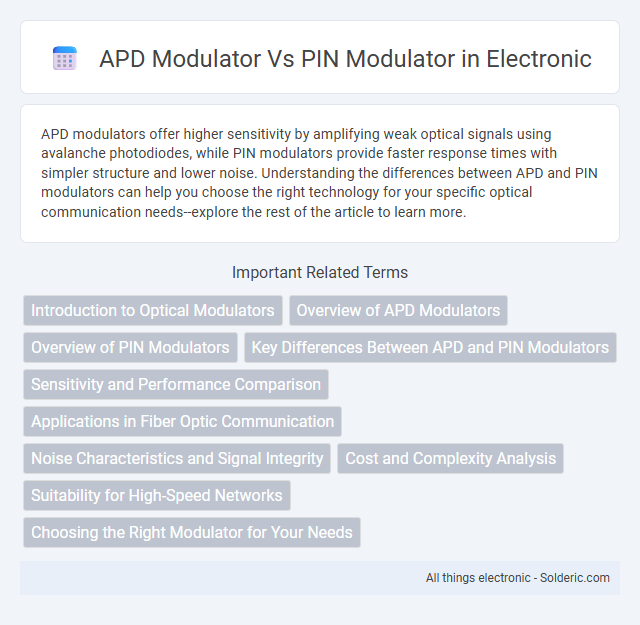APD modulators offer higher sensitivity by amplifying weak optical signals using avalanche photodiodes, while PIN modulators provide faster response times with simpler structure and lower noise. Understanding the differences between APD and PIN modulators can help you choose the right technology for your specific optical communication needs--explore the rest of the article to learn more.
Comparison Table
| Feature | APD Modulator | PIN Modulator |
|---|---|---|
| Type | Avalanche Photodiode based | Positive-Intrinsic-Negative diode based |
| Sensitivity | High sensitivity due to internal gain | Lower sensitivity without gain |
| Gain | Internal avalanche multiplication | No internal gain |
| Response Speed | Slower than PIN due to avalanche process | Faster response time |
| Noise | Higher noise from avalanche multiplication | Lower noise level |
| Operating Voltage | High voltage required (typically 100-200 V) | Low voltage operation (typically 5-20 V) |
| Cost | More expensive | Cost-effective |
| Applications | Long-distance fiber optics, low-light detection | Short to medium range communication |
Introduction to Optical Modulators
Optical modulators control light signals in fiber optic communications, with APD and PIN modulators serving distinct functions. An APD modulator integrates an avalanche photodiode, offering high sensitivity and internal gain for detecting weak optical signals. Your choice between APD and PIN modulators depends on factors like speed, sensitivity, and system requirements in optical networks.
Overview of APD Modulators
APD modulators leverage avalanche photodiodes to amplify optical signals through internal gain, improving sensitivity in high-speed optical communication systems. These modulators enable enhanced signal-to-noise ratios compared to PIN modulators, making them ideal for long-distance fiber optic links. Their capability to maintain high bandwidth while providing gain distinguishes APD modulators from conventional PIN diode-based modulators.
Overview of PIN Modulators
PIN modulators utilize a PIN diode to control light intensity by varying the injected current, offering high linearity and fast response times suitable for high-speed optical communication systems. Compared to APD modulators, PIN modulators provide lower noise performance and simpler biasing requirements but typically have less sensitivity due to the absence of internal gain. Your choice depends on application needs, with PIN modulators excelling in scenarios prioritizing bandwidth and linearity over sensitivity.
Key Differences Between APD and PIN Modulators
APD modulators utilize avalanche photodiodes to amplify weak optical signals through internal gain, enhancing sensitivity in low-light conditions, whereas PIN modulators rely on a simple p-type, intrinsic, and n-type layer structure without gain, resulting in faster response times but lower sensitivity. APD modulators generally exhibit higher noise due to avalanche multiplication, impacting signal-to-noise ratio, while PIN modulators maintain lower noise levels, making them ideal for higher bandwidth applications. Your choice between APD and PIN modulators should balance the need for sensitivity versus speed and noise performance based on the specific optical communication requirements.
Sensitivity and Performance Comparison
APD modulators provide higher sensitivity compared to PIN modulators due to their internal avalanche gain mechanism, which amplifies weak optical signals before conversion. This results in enhanced performance in low-light or high-noise environments, making APD modulators ideal for long-distance fiber optic communication where signal integrity is critical. Your choice between APD and PIN modulators depends on the required sensitivity and system complexity, as APD devices typically consume more power and exhibit higher noise levels than PIN photodiodes.
Applications in Fiber Optic Communication
APD modulators excel in long-haul fiber optic communication due to their high sensitivity and low noise characteristics, making them ideal for detecting weak optical signals over extensive distances. PIN modulators, with faster response times and simpler structure, are preferred in short-reach applications such as data centers and local area networks where high-speed modulation is critical. The choice between APD and PIN modulators depends on balancing sensitivity requirements with speed and cost constraints in fiber optic communication systems.
Noise Characteristics and Signal Integrity
APD modulators exhibit lower noise figures compared to PIN modulators due to their internal avalanche gain, enhancing signal integrity by amplifying weak optical signals before conversion. However, the excessive avalanche multiplication in APDs can introduce excess noise, affecting bit error rates in high-speed communication. Your choice between APD and PIN modulators should consider the balance between noise performance and signal fidelity required for your optical system.
Cost and Complexity Analysis
APD modulators generally incur higher costs due to the need for avalanche photodiode components and complex biasing circuits, increasing overall system complexity. PIN modulators offer a cost-effective alternative with simpler design and lower power consumption, making them suitable for large-scale deployment. The trade-off between APD and PIN modulators involves balancing sensitivity and noise performance against economic and design simplicity constraints.
Suitability for High-Speed Networks
APD modulators offer higher sensitivity, making them suitable for long-distance, high-speed networks where signal integrity is critical. PIN modulators excel in high-speed applications with lower noise but require stronger signal amplification for long-distance transmission. Your choice depends on balancing sensitivity requirements with network speed and distance demands.
Choosing the Right Modulator for Your Needs
Choosing the right modulator depends on your application's sensitivity and bandwidth requirements; APD modulators offer higher sensitivity due to avalanche multiplication, making them ideal for long-distance or low-signal environments. In contrast, PIN modulators provide faster response times and broader bandwidth, better suited for short-reach or high-speed communication links. Evaluating your signal strength, noise tolerance, and speed demands ensures optimal performance with either an APD or PIN modulator.
APD modulator vs PIN modulator Infographic

 solderic.com
solderic.com